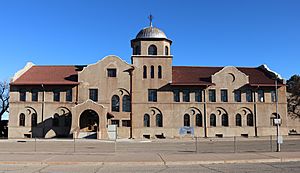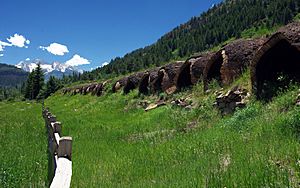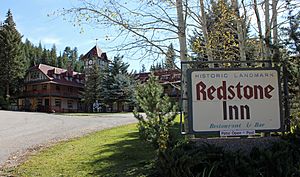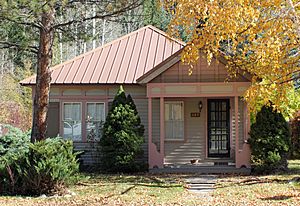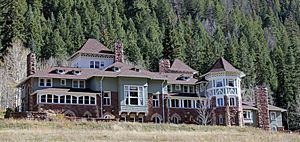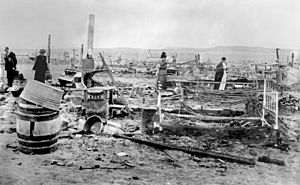John C. Osgood facts for kids
Quick facts for kids
John Cleveland Osgood
|
|
|---|---|
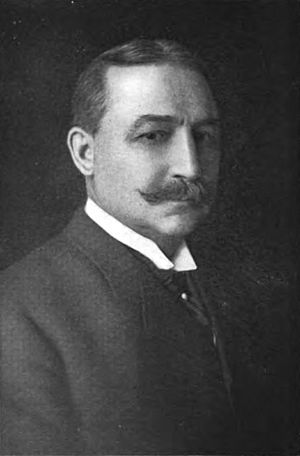 |
|
| Born | March 6, 1851 |
| Died | January 3, 1926 (aged 74) |
| Occupation | Industrialist |
| Spouse(s) | Nannie Irene de Belote 1891-? Alma Regina Shelgrem Lucille |
John Cleveland Osgood (born March 6, 1851 – died January 3, 1926) was a very successful businessman. He started big companies like the Colorado Fuel and Iron Company and the Victor-American Fuel Company. Some people called him a "robber baron" because of how he built his wealth. He also founded the town of Redstone, Colorado.
Contents
John Osgood's Life Story
Early Years and Business Start
John Osgood was born in Brooklyn, New York. When he was six, he moved with his father to Burlington, Iowa. After his father passed away in 1859, John went to live with family in Providence, Rhode Island. There, he went to school.
At 14, he started working in a cotton mill office. This is where he learned a lot about business. At 16, he moved to New York City. He worked for a company that dealt with farm products and went to night school. After three years, he returned to Iowa. He worked as a cashier for a fuel company and then for a bank. By age 26, he was in charge of the White Breast Fuel Company.
Building Coal Companies in Colorado
In 1882, John Osgood traveled to Colorado. His job was to study the state's coal resources for a railroad company. He visited every mine and learned all he could. Colorado was a new state, and few people saw the potential in coal like Osgood did.
He started buying large areas of coal land. In 1887, he created the Colorado Fuel Company. This business grew very fast. Five years later, his company joined with another to form the Colorado Fuel and Iron Company (CF&I). This became the biggest company of its kind in Colorado. The main office was in Pueblo, Colorado.
Workers went on strike in 1894 and 1901. These strikes cost CF&I a lot of money. Osgood believed that company leaders knew what was best for their workers. He thought that labor unions were a danger to the country.
Osgood decided to try something called "welfare capitalism." This was a way to try and make workers happy so they wouldn't need unions or go on strike. The idea was that happy workers would do more work. CF&I built a modern hospital in Pueblo for its employees.
Redstone: A Special Company Town
John Osgood built the town of Redstone, Colorado in the late 1800s. It was a company town, meaning the company owned most of it. They built 249 coke ovens there. These ovens turned coal into coke, which is a fuel used in factories. A railroad was built to move coal from nearby mines to Redstone. It also moved the coke to factories in Pueblo.
Redstone was Osgood's big experiment in welfare capitalism. Most mining towns had very basic housing. But Osgood built 84 nice cottages for married workers. He also built a 40-room building for single workers. All these homes had indoor plumbing and electricity.
A school was built for the children of the workers. The Redstone Club was finished in 1902. It cost $25,000, which was a lot of money back then. The club had reading rooms with newspapers and magazines in different languages. It also had a library, a small theater, and a bathhouse. Workers could shower and change clothes there after work.
The Club also had a saloon, a place where people could relax. It had card tables and pool tables. There were strict rules to prevent too much drinking. For example, you couldn't buy drinks for a whole group of people. Only small bets were allowed on card games and pool.
Other things in Redstone included a community garden. Workers could use a few acres to grow vegetables. There was also a public barn for workers' animals and a wash house for laundry.
Osgood's Castle Home
About a mile from Redstone is Cleveholm Manor. People often call it "Redstone Castle" or "Osgood Castle." It's a very fancy 42-room mansion. Osgood built it for his second wife, Alma Regina Shelgrem. The house was designed by architects from New York. It was started in 1897 and finished in 1901. It cost $50,000 at the time.
The Castle was part of a large estate. This estate also had homes for servants, a lodge for the gamekeeper, a carriage house, and a greenhouse. There were two gatekeeper's lodges at the edges of the property. The estate had a kennel for dogs and a stable for 25 horses. There were also cows, pigs, and chickens. The nearby land was a game preserve with deer, elk, and bighorn sheep. There was also a pond for fishing.
Losing Control of CF&I
A strike at other coal mines made CF&I financially weak. John Osgood managed to stop another businessman from taking over his company. However, in 1903, rich businessmen John D. Rockefeller and the heirs of Jay Gould won a fight to control the company's stock.
Osgood lost control of CF&I. But he still owned the town of Redstone and Cleveholm Castle. The new leaders of CF&I did not support Osgood's social programs for workers. So, Osgood had to stop his experiment in Redstone. No similar programs were tried again. To fight against workers forming unions, Osgood used strong tactics. He brought in new workers from other countries and hired groups that didn't get along. He also worked with local and state governments and other mine owners.
After starting the Victor-American Fuel Company, Osgood spent less time at Cleveholm. He mostly lived in New York City. He traveled often, visiting places like Palm Beach, Florida and going on cruises to Europe. Cleveholm Castle was closed up in 1913.
The Big Mine Strike
There was a large mine strike across Colorado from 1913 to 1914. By this time, John D. Rockefeller Jr. was in charge of CF&I. However, he was often away.
The three biggest mining companies, including CF&I and Victor American, worked together during the strike. John Osgood was the main voice for the companies. He started a campaign to make the workers and their union look bad. He pushed the Colorado Governor to send the National Guard to the mines. After the strike, he used his influence to have strikers put on trial. Rockefeller's ideas for reforms were delayed because Osgood insisted on it. Rockefeller thought Osgood was trying to make him sell his share of CF&I back to Osgood.
The mine owners refused to talk with the union or agree to government help. Over a year, anger grew on both sides. This led to a tragic event called the Ludlow Massacre in 1914. In 1917, the Victor American Hastings Mine Disaster happened, killing 121 people.
Later Life and Legacy
John Osgood married three times but did not have any children. He and Lucille, his third wife, returned to Redstone in 1925. He had been diagnosed with a serious illness. Osgood passed away at Cleveholm Castle in 1926. His ashes were spread in the Crystal River valley. Lucille tried to turn the estate into a vacation spot, but the worldwide economic downturn of 1929 stopped her plans.
Cleveholm Manor, or Osgood Castle, and the gamekeeper's cottage are both important historical places. They are listed on the National Register of Historic Places. As of 2004, the Castle still had most of its original furniture. The historic dormitory in Redstone is now a hotel called the Redstone Inn. Many of the cottages are still used as homes today. The Redstone Coke Oven Historic District was created to protect the old coke ovens. Some will be fixed up.
Images for kids
See also
 In Spanish: John C. Osgood para niños
In Spanish: John C. Osgood para niños


